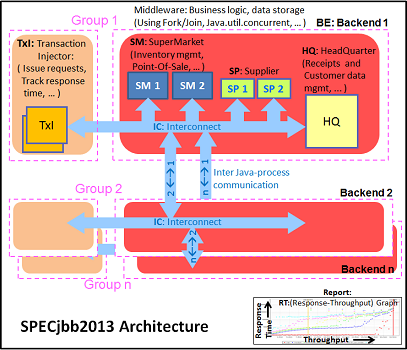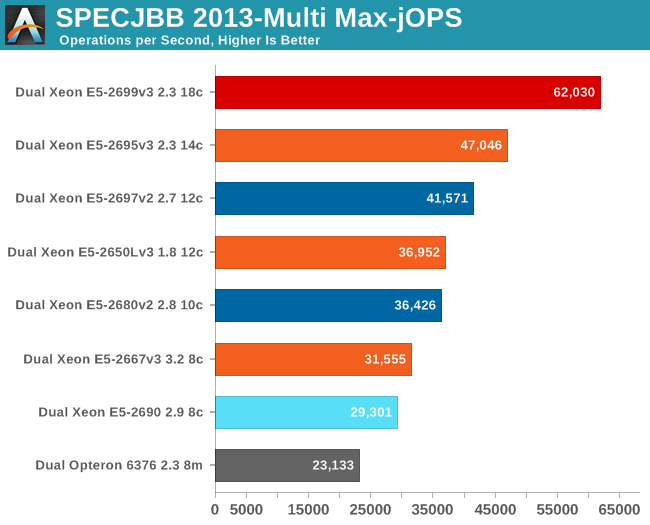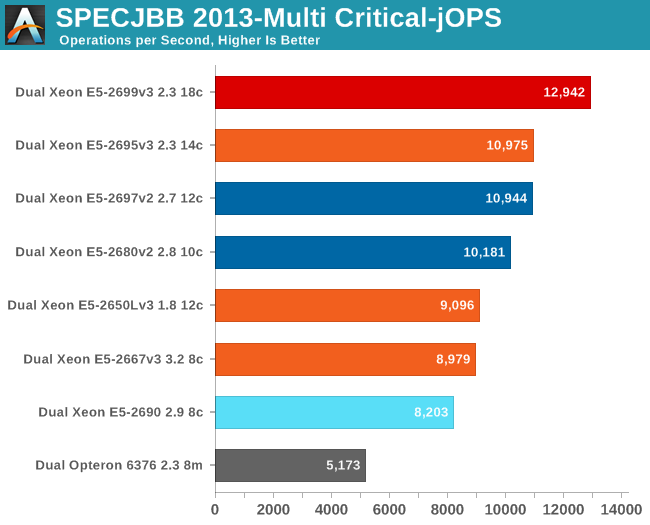Intel Xeon E5 Version 3: Up to 18 Haswell EP Cores
by Johan De Gelas on September 8, 2014 12:30 PM ESTJava Server Performance
According to the documentation, the SPECjbb 2013 benchmark has "a usage model based on a world-wide supermarket company with an IT infrastructure that handles a mix of point-of-sale requests, online purchases, and data-mining operations". It uses the latest Java 7 features and makes use of XML, compressed communication, and messaging with security. We tested with four groups of transaction injectors and backends.

Several readers commented that we should try to optimize for lower response times instead of just optimizing for maximum throughput, so we have changed our relatively basic tuning. We left out "+AggressiveOpts" as this is still somewhat a risk for stability and the performance does not increase tangibly, and we used "-XX:+AlwaysPreTouch". Also we are more generous with the amount of allocated memory. These results are thus no longer comparable to our previous results. Our full parameters are:
"-server -Xmx8G -Xms8G -Xmn4G -XX:+AlwaysPreTouch -XX:+UseLargePages"
With these settings, the benchmark takes about 47GB-52GB of RAM. The first metric is basically maximum throughput.

Our new tuning has resulted in higher results, and all of the new Xeon scale well. However, if you start looking at it from a performance/watt perspective, the results are good but not spectacular. The power consumption of the Xeon E5-2695 v3 is similar to the Xeon E5-2697 v2, and the former has a 13% performance advantage.
The Critical-jOPS metric, is a throughput metric under response time constraint (SLA).

With our new tuning, the critical jOPS make a lot more sense, so we believe we have taken a step forward. Notice that the Xeon E5-2695 v3, despite its clock speed disadvantage (2.3 at least, 2.8 at the most), is capable of keeping up with the Xeon E5-2697 v2 (2.7 at the least, 3GHz at the most). The improvements in Haswell are measureable.
However, it must be said that while this is a step forward if you're buying a server, it's not a large one. You get 13% more throughput and the same response time for a few hundred dollars less (Xeon E5-2695 v3 vs E5-2697 v2).










85 Comments
View All Comments
martinpw - Monday, September 8, 2014 - link
There is a nice tool called i7z (can google it). You need to run it as root to get the live CPU clock display.kepstin - Monday, September 8, 2014 - link
Most Linux distributions provide a tool called "turbostat" which prints statistical summaries of real clock speeds and c state usage on Intel cpus.kepstin - Monday, September 8, 2014 - link
Note that if turbostat is missing or too old (doesn't support your cpu), you can build it yourself pretty quick - grab the latest linux kernel source, cd to tools/power/x86/turbostat, and type 'make'. It'll build the tool in the current directory.julianb - Monday, September 8, 2014 - link
Finally the e5-xxx v3s have arrived. I too can't wait for the Cinebench and 3DS Max benchmark results.Any idea if now that they are out the e5-xxxx v2s will drop down in price?
Or Intel doesn't do that...
MrSpadge - Tuesday, September 9, 2014 - link
Correct, Intel does not really lower prices of older CPUs. They just gradually phase out.tromp - Monday, September 8, 2014 - link
As an additional test of the latency of the DRAM subsystem, could you please run the "make speedup" scaling benchmark of my Cuckoo Cycle proof-of-work system at https://github.com/tromp/cuckoo ?That will show if 72 threads (2 cpus with 18 hyperthreaded cores) suffice to saturate the DRAM subsystem with random accesses.
-John
Hulk - Monday, September 8, 2014 - link
I know this is not the workload these parts are designed for, but just for kicks I'd love to see some media encoding/video editing apps tested. Just to see what this thing can do with a well coded mainstream application. Or to see where the apps fades out core-wise.Assimilator87 - Monday, September 8, 2014 - link
Someone benchmark F@H bigadv on these, stat!iwod - Tuesday, September 9, 2014 - link
I am looking forward to 16 Core Native Die, 14nm Broadwell Next year, and DDR4 is matured with much better pricing.Brutalizer - Tuesday, September 9, 2014 - link
Yawn, the new upcoming SPARC M7 cpu has 32 cores. SPARC has had 16 cores for ages. Since some generations back, the SPARC cores are able to dedicate all resources to one thread if need be. This way the SPARC core can have one very strong thread, or massive throughput (many threads). The SPARC M7 cpu is 10 billion transistors:http://www.enterprisetech.com/2014/08/13/oracle-cr...
and it will be 3-4x faster than the current SPARC M6 (12 cores, 96 threads) which holds several world records today. The largest SPARC M7 server will have 32-sockets, 1024 cores, 64TB RAM and 8.192 threads. One SPARC M7 cpu will be as fast as an entire Sunfire 25K. :)
The largest Xeon E5 server will top out at 4-sockets probably. I think the Xeon E7 cpus top out at 8-socket servers. So, if you need massive RAM (more than 10TB) and massive performance, you need to venture into Unix server territory, such as SPARC or POWER. Only they have 32-socket servers capable of reaching the highest performance.
Of course, the SGI Altix/UV2000 servers have 10.000s of cores and 100TBs of RAM, but they are clusters, like a tiny supercomputer. Only doing HPC number crunching workloads. You will never find these large Linux clusters run SAP Enterprise workloads, there are no such SAP benchmarks, because clusters suck at non HPC workloads.
-Clusters are typically serving one user who picks which workload to run for the next days. All SGI benchmarks are HPC, not a single Enterprise benchmark exist for instance SAP or other Enterprise systems. They serve one user.
-Large SMP servers with as many as 32 sockets (or even 64-sockets!!!) are typically serving thousands of users, running Enterprise business workloads, such as SAP. They serve thousands of users.